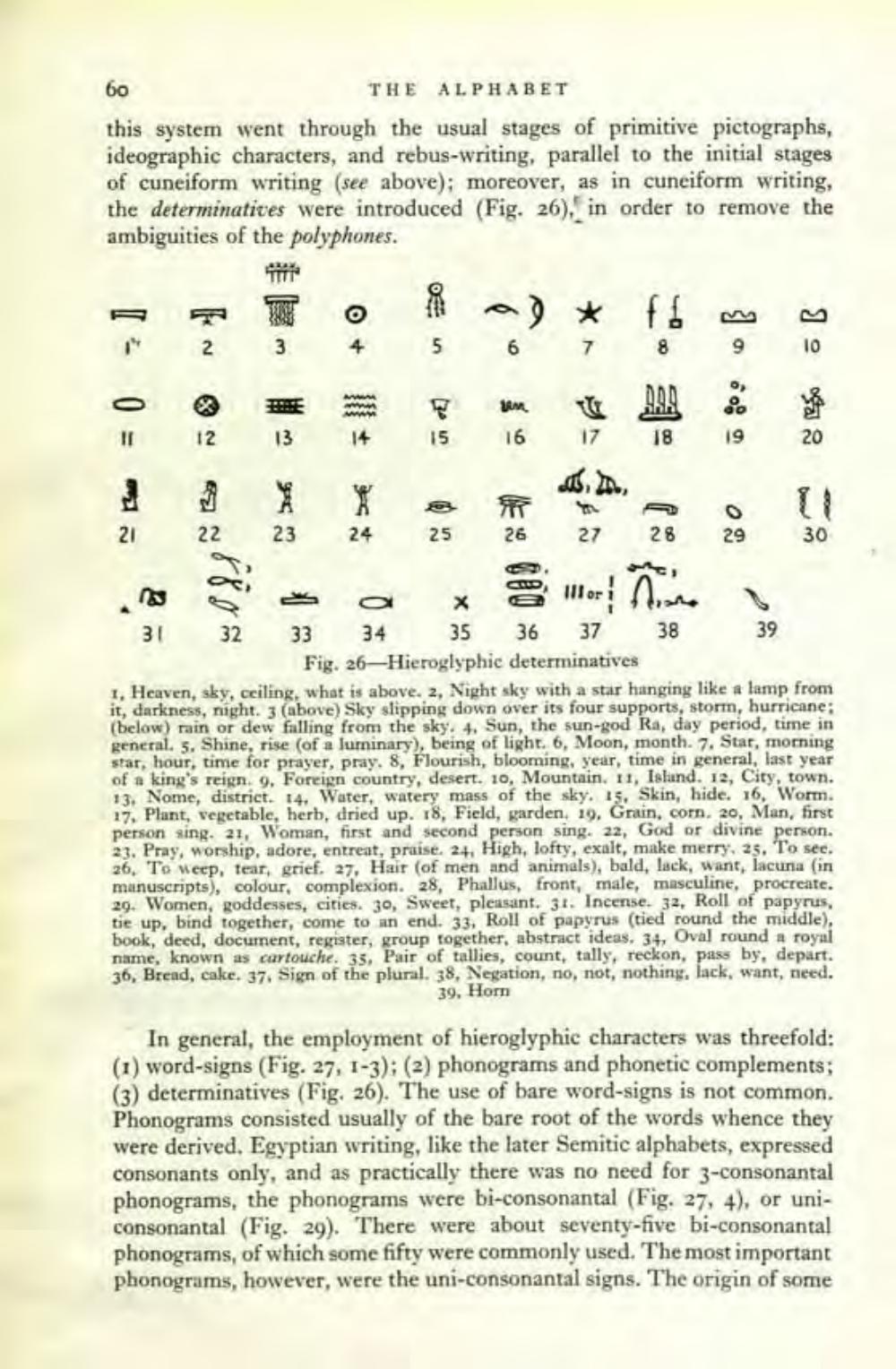________________
60
THE ALPHABET
this system went through the usual stages of primitive pictographs, ideographic characters, and rebus-writing, parallel to the initial stages of cuneiform writing (see above); moreover, as in cuneiform writing, the determinatives were introduced (Fig. 26), in order to remove the ambiguities of the polyphones.
0 =
21
763
31
मूल
2
12
22
880
32
3
13
23
+0
4
24
0
34
$
5
170 55
15
8
25
~) * fb
6
7
8
sen
16
FR
26
近
17
5, 20,
43
27
28
MC1
Illor Are
38
999
18
X
35 36 37
。。。
29
39
B
10
20
(1
30
33
Fig. 26-Hieroglyphic determinatives
1, Heaven, sky, ceiling, what is above. 2, Night sky with a star hanging like a lamp from it, darkness, night. 3 (above) Sky slipping down over its four supports, storm, hurricane; (below) rain or dew falling from the sky. 4, Sun, the sun-god Ra, day period, time in general. 5. Shine, rise (of a luminary), being of light. 6, Moon, month. 7, Star, morning star, hour, time for prayer, pray. 8, Flourish, blooming, year, time in general, last year of a king's reign. 9, Foreign country, desert. 10, Mountain. 11, Island. 12, City, town. 13, Nome, district. 14, Water, watery mass of the sky. 15, Skin, hide. 16, Worm. 17, Plant, vegetable, herb, dried up. 18, Field, garden, 19, Grain, corn, 20, Man, first person sing. 21, Woman, first and second person sing. 22, God or divine person. 23. Pray, worship, adore, entreat, praise. 24, High, lofty, exalt, make merry, 25. To see. 26, To weep, tear, grief. 27, Hair (of men and animals), bald, lack, want, lacuna (in manuscripts), colour, complexion. 28, Phallus, front, male, masculine, procreate. 29. Women, goddesses, cities. 30, Sweet, pleasant, 31. Incense. 32, Roll of papyrus, tie up, bind together, come to an end. 33, Roll of papyrus (tied round the middle), book, deed, document, register, group together, abstract ideas, 34, Oval round a royal name, known as cartouche. 35, Pair of tallies, count, tally, reckon, pass by, depart. 36, Bread, cake. 37, Sign of the plural. 38, Negation, no, not, nothing, lack, want, need. 39, Horn
In general, the employment of hieroglyphic characters was threefold: (1) word-signs (Fig. 27, 1-3); (2) phonograms and phonetic complements; (3) determinatives (Fig. 26). The use of bare word-signs is not common. Phonograms consisted usually of the bare root of the words whence they were derived. Egyptian writing, like the later Semitic alphabets, expressed consonants only, and as practically there was no need for 3-consonantal phonograms, the phonograms were bi-consonantal (Fig. 27, 4), or uniconsonantal (Fig. 29). There were about seventy-five bi-consonantal phonograms, of which some fifty were commonly used. The most important phonograms, however, were the uni-consonantal signs. The origin of some




